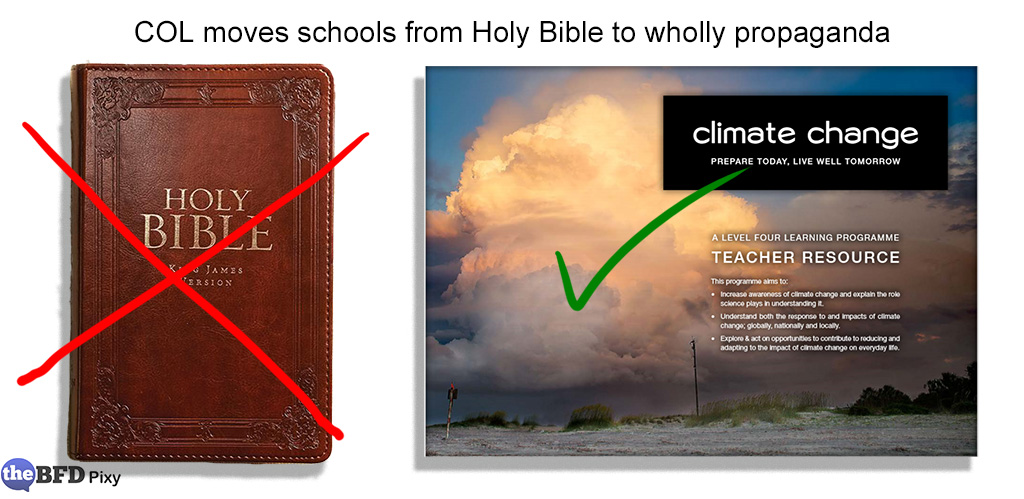Editor’s note: Part Four is the final article in the series and it is a detailed analysis of the ‘myths’ about Climate Change and their supposed refutations by Jock Allison.
An analysis by Dr Jock Allison of flaws in the science presented, focusing on the so-called myth busters in Session 7, is included below as an Appendix.
Appendix
Comment on the Climate Change Curriculum from a scientific perspective, from Dr Jock Allison, ONZM, FNZIPIM, former Director of AgResearch Invermay
The information has many glaring errors of fact. This document considers the 28 “Climate Myths” on Page 38 of the Resource material and the response implied to be the accurate situation based on science.
(The alleged “Myths” are shown in bold black type, versus “What the Science says”, according to the resource material is underlined and then the actual situation as indicated by the real science is in italics.)
Most of the information stated as science-based fact is alarmist and not indicated by the science. Much of the material (see Myth 27) illustrates a complete ignorance about climate change and simple atmospheric physics.
1. “Climate has changed before”: Climate reacts to whatever forces it to change at the time :humans are now the dominant factor.
Humans are not the dominant factor, they have a very minor effect. If all the Paris 2015 commitments are kept through to 2100 the maximum effect on temperature could be 0.17 degrees C. See Myth 24.
2. “It is not bad”: Negative effects of global warming on agriculture, health & environment far outweigh any positives.
This is nonsense. A comprehensive report prepared for MAF in 2008, indicated little effect on NZ’s agricultural production through to 2100. Further effects on health are overstated, and a warm planet is a lot healthier place to be than a cooling planet.
3. “There is no consensus”: 97% of scientists agree humans are causing global warming.
Again the warmist claims are not based on sound science, the so called consensus is simply warmist propaganda see “Why Scientists Disagree About Global Warming“. There is no such thing as “consensus” in science and the so called consensus(s) don’t exist.
4. “Its Cooling”: On average 2000 to 2009 was the hottest decade on record.
Climate records exist only from abut 1860, a mere speck of geological time. It is clear from many scientific references that the Medieval Warm Period (900 to 1300 AD) and the Roman Warm Period (2000 years ago) were both warmer … see figure
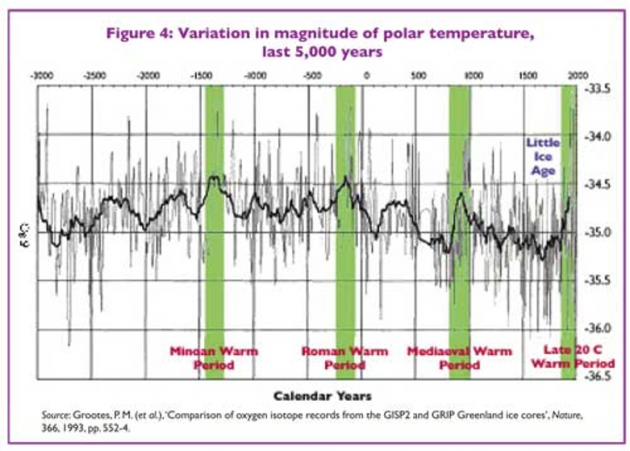
There is nothing unusual in the present weather and climate patterns from evidence over the past several thousand years.
5. “Animals and plants can adapt”: Global warming will cause mass extinctions of species that cannot adapt on short term time scales.
Alarmist assumptions, there is no guarantee that the planet will continue to warm, in fact, there is every indication that some cooling might be on the way.
6. “It hasn’t warmed since 1998”: Every part of the earth’s climate system has continued warming since 1998, with 2015 shattering temperature records.
This is a standard response using land-based data. There are many variations of such a graph …
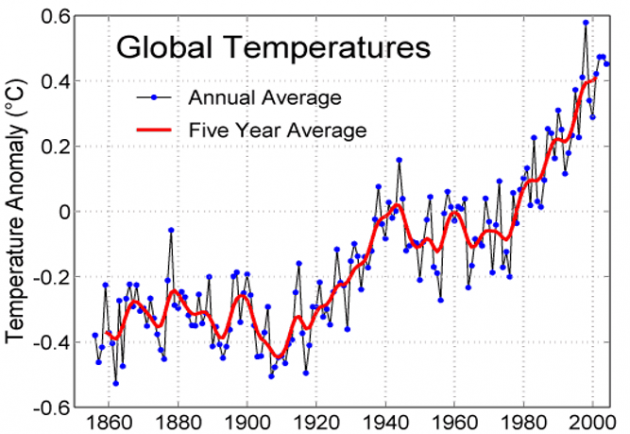
There is a significant effect of the errors due to poorly sited climate measurement stations in the land-based climate records, i.e. the UHI effect (Urban Heat Island), and this is well illustrated in the difference between the land based record and the new Climate Reference Network (CRN) set up about 2004 by NOAA (National Oceanic and Atmospheric Administration) in the US set up the CRN network where 120 new stations without any possible outside interference with the climate measurements were established throughout the USA. Early results are below (from The USCRN Revisited)…
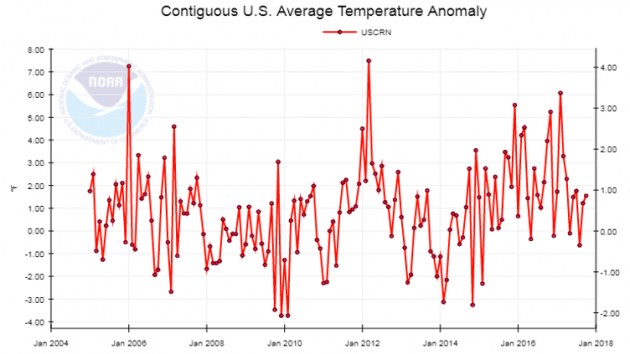
This doesn’t look like continued warming since 1998, in fact, it seems to show natural variation with little warming. Not unsurprisingly NOAA in the USA continue to use the previous land-based records, as they fit the narrative of continued warming.
In addition, the lower atmospheric record (Trophosphere) also doesn’t show continued upward movement in temperature thus the educational resource response information is incorrect.
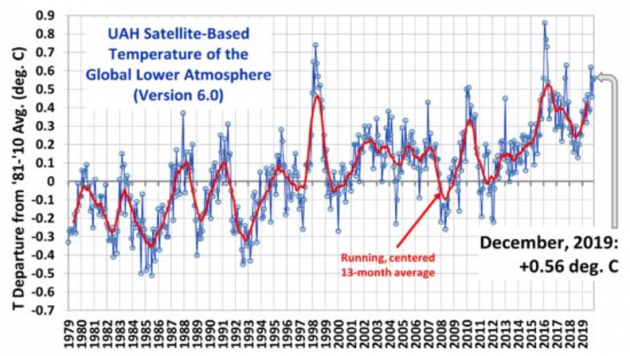
Further, the climate models on which warming predictions are made overestimate warming by a factor of about 3 times.
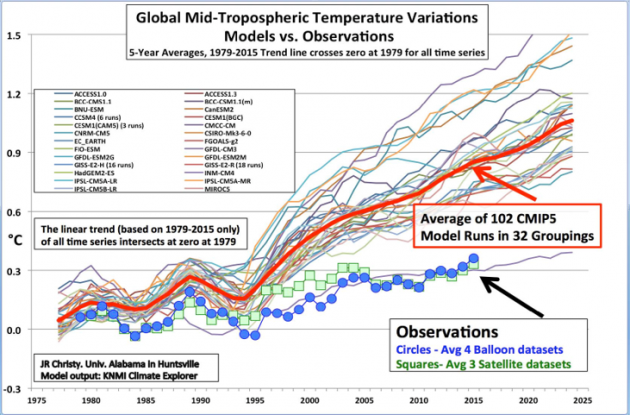
7. “Its cold”: A local cold day has nothing to do with the long-term trend of increasing global temperatures.
The suggestion that “its cold” is a climate myth is just silly.
8. “Extreme weather isn’t caused by global warming”: Extreme weather events are being made more frequent and worse by climate change.
Again this is not the case, as exemplified in several reviews see review by New Zealand’s Professor (Engineering) Mike Kelly from Cambridge in the UK.
As the narrative has changed from global warming, to climate change, now it has progressed to climate disruption / extreme weather, and we get virtually every weather event attributed to climate change. This is simply not the case. There is no strong scientific evidence that climate change caused by humans has effects on extreme weather as frequently claimed by Government scientists.
9. “Climate Scientists are in it for the Money”: Climate scientists could make more money in other careers, most notably working for the oil industry.
Again this comment is simply silly. Most climate scientists would be unsuitably qualified for employment in the oil industry. The so-called myth above comes from the situation where …
- Global warming mainly caused by humans is Government policy at least since 1992 when at the Rio earth Summit in Rio, Brazil 130 governments signed up to the UNFCCC (United Nations Foundation Convention on Climate Change) which included agreement with that assumption (human emissions are causing warming) in spite of the fact that there was no scientific proof of the contention. Subsequently many / most of the remaining world countries have signed.
- Governments pay all of the education sector, primary, secondary and tertiary where many / most of the world’s climate scientists are employed,
- Governments pay most of the research institutions and all of the research grants for research on climate change,
- Government bureaucrats have the final say on the wording of “the Summary for Policy Makers” summaries for the IPCC reports. Many changes made by the bureaucrats pushing their political agendas, are not supported by the science!
- Thus any scientists who has an alternative view about climate science in any of the Universities or Research & Development Institutions is usually ostracised and or loses his / her job and the remuneration that goes with it, Thus the “Climate scientists are in it for the money” Myth, relates to the fact that if scientists speak out against the ongoing scientific mantra, then it most likely will be career ending, and the financial consequences stop most. Such “freedom of speech” is not allowed in our universities.
10. “Human CO2 is a tiny % of CO2 emissions”: The natural cycle adds and removes CO2 to keep a balance, humans add extra CO2 without removing any.
So what! one might say? The amount of CO2 from human activities is only 3-4% of all the CO2 which goes into the atmosphere each year, and the human influences on the climate are a small (1%) perturbation to natural energy flows. How this minor influence can be construed to be the driver of climate is mystifying indeed.
11. “Polar Bear Numbers are Increasing”: Polar Bears are in danger of extinction as well as many other species.
Again this is just silly, Polar Bear Numbers are higher than they have ever been since population number estimates have been attempted. The facts are that in the 1950s the numbers were down to about 5,000, and have been increasing since then, to a figure of 30,000 or more, no danger of extinction. See 10 Good Reasons Not to Worry About Polar Bears, from Dr Susan Crockford, evolutionary biologist and expert on polar bear evolution.
12. “CO2 limits will harm the Economy”: The benefits of a price on carbon outweigh the costs several times over.
Again we have a glib definitive statement completely without justification. What would the primary school kids understand about “a cost on carbon”, very little I suggest. The statement in the document I assume is meant to say that imposed costs to achieve reductions in CO2 (not carbon) emissions will be small in comparison to the costs of damages re climate change if we don’t reduce emissions.
There are no reliable data concerning such a contention, we, in fact, have no idea whether there will be continued warming, and whether this will have real costs at all? All the contentions are based on “computer models” which thus far are predicting much higher warming than has been recorded over the past few decades. See Myth 6.
13. “It’s a Natural Cycle”: No known natural forcing fits the fingerprints of observed warming except anthropogenic greenhouse gases.
This says “in our computer models, we can’t think of anything else that is causing warming, so it must be CO2”. This is completely unscientific? There is no fitting with any fingerprint of observed warming.
14. “Scientists can’t even predict the weather”: Weather and climate are different, climate predictions do not need weather detail.
Not sure where this myth came from? When the climate models are “running hot” (see Myth 6, then where dos the confidence about the predictions of future warming come from? How is it that the scientists are confident that the climate will simply keep on warming? There is no consideration in any of the scenarios of any cooling, which is quite possible in the future?
15. “CO2 limits will hurt the poor”: Those who contribute the least greenhouse gases will be most impacted by climate change.
Not sure where this contention comes from? Those who contribute the lowest levels of Greenhouse Gas emissions are certainly the least developed countries, many of which are being denied cheap energy (coal) to allow them to develop and improve their standard of living.
A good question for the school children could be “do you have the moral right to suggest that undeveloped countries be restricted in their development by reducing their own emissions”. Clearly the answer to this is no.
In fact under the Paris Agreement 2015, Developing Countries have the right to keep improving their standard of living until 2030 at least.
Also CO2 limits and massive reductions touted as required to reduce warming will be politically unacceptable, and practically impossible. Consider ……
- Undeveloped countries are responsible for 63% of the world’s emissions,
- From 1990 to 2013, the world’s total emissions increased by 60%, not much indication of any commitment to reduce emissions there?
- From 2017 and 2018 the world’s emissions increased by another 4%.
- Under Paris 2015, China indicated emissions would double to 2030 +29.5%
- Under Paris 2015, India indicated emissions would triple to 2030, +14%
- It is assumed that by 2030, the other developed countries will increase emissions. + 10%
- Total world emissions increase as undeveloped countries improve their standard of living, 5%, say 50%
- Of the remaining 37% of world emissions (100% minus 63% see a) above), America (16%) has pulled out of the Paris Agreement.
- This leaves the remaining developed countries reputedly trying to reduce emissions from the 23% of the world’s share that they have.
- New Zealand has 0.17% of the world emissions, or about 1/135th of the 23%.
- Conclusion: the actual world’s emissions will not reduce much by 2030 at least. It simply isn’t possible and the strenuous efforts being made under false pretences in New Zealand (CO2 is not the main driver of climate change) will have no effect other than making all New Zealanders poorer, especially the lower strata of society. This will be about $3,000 / household / annum or more than $1,000 / annum per individual in NZ’s population.
16. “Volcanos emit more CO2 than humans”: Humans emit 100 times more CO2 than volcanos.
Not sure how this is calculated, and whether undersea volcanos are included. Certainly the Pinatubo eruption in 1991 caused some earth cooling over the subsequent 2 or 3 years, 0.4 to 0.7 degrees C. Clearly volcanoes are unpredictable, not under human influence, but potentially of massive capability.
17. “Record snowfall disproves global warming”: Warming leads to increased evaporation and precipitation, which falls as increased snow in the winter.
Any record temperatures, precipitation via rain or snowfall at individual places on the globe, do not prove anything about the world’s climate.
18. CO2 limits will make little difference” – (presumably to climate?): If every nation agrees to limit CO2 emissions, we can achieve significant cuts on a global scale.
Can’t argue with this, BUT whether this will have any effect on climate is another matter. It is clear that water vapour is the main Greenhouse Gas, and that methane and nitrous oxide are of trivial importance, and CO2 not much above them (see Allison and Sheahan, Greenhouse Gases: a More Realistic View (pdf), or a popular version from a farming newspaper, “Water blamed as big planet warmer”).
Thus cutting emissions will have a negligible effect on the temperature. Humans are naive enough to think they can control the climate through manipulation of CO2 – they can’t control the climate and CO2 is not the main driver anyway. Huge negative impacts on the agricultural economy are not justified for no predictable outcome.
19. “Renewable energy is too expensive: When you account for all the costs associated with burning coal and other fossil fuels, like air pollution and health effects, they are significantly more expensive than most renewable energy sources.
Not sure what this is about? If renewables wind and solar were so economically attractive then why after the technologies being available for the last 20 to 30 years, do they not have a greater share of world energy. Presently world energy use is still about 85% fossil fuels and renewables are very minor contributors ….
(From “The Energy emergency and the Space Option”)
Some reality is required as to what is possible re alternative fuels and the disadvantages of the high levels of renewables being integrated into national grids. Blackouts in South Australia is a good example of the unreliability of significant levels of wind and solar.
Certainly discussion of alternative energy supplies is a relevant education topic, but that discussion should be based on reality, not green ideologies. A rapid shift away from fossil fuels is simply not practically or economically possible. Clearly the response here (blue typing above) is unrealistic.
20. “Humans are too insignificant to affect global climate”: Humans are small but powerful, and human CO2 emissions are causing global warming.
This is a very glib and inaccurate comment. Humans are pretty insignificant on the world scale. For examples in terms of total biomass volume, humans make up about half a cubic km – this in comparison with the 30 million cubic km of ice on earth. The education comment above is based on the assumption that human CO2 drives climate change. There is no good scientific evidence for that. I.e. the climate models are nowhere near predicting the climate.
21. “It’s too hard”: Scientific studies have determined that current technology is enough to reduce greenhouse gas emissions to avoid dangerous climate change.
Again this is nonsense. It simply isn’t possible!! If there was the resolve to reduce emissions while we had the world agreement (we have had the world governments agreeing that emissions should be reduced since 1992, and yet since that time the total world emissions have increased by more than 60%. Simply there is no practical resolve or commitment to make the massive reductions possible.
There is not the technology available as contended above, no technology available for Carbon Recapture & Storage which has no example of working on a large sale anywhere, no technology available for the reduction of methane etc.
A good education discussion in schools would be the massive protests in Chile, France, Holland and Germany when Governments have tried to impose emissions reductions policies, for example here and here. Politics is the art of the possible, already government policies are having to be modified on the basis of protests.
22. “It’s not urgent”: A large amount of warming is delayed, and if we don’t act now, we could pass tipping points.
What tipping points? There is no good scientific information which suggests that such tipping points exist. There have been many doomsday predictions made in the past few decades. Al Gore has made many predictions re temperature rise and disappearing Arctic Ice, which haven’t happened, similarly Prince Charles has made many such predictions along with many other politicians and scientists. For a catalogue of failed predictions, see “50 Years of Failed Doomsday Eco-Pocalyptic Predictions: the So-Called Experts Are 0-50” .
Even the UN say that climate policy is not about climate …” We redistribute de facto the world’s wealth by climate policy” … “One has to free oneself from the illusion that international climate policy, is environmental policy, it has almost nothing to do with environmental policy anymore” Dr Otttmar Endenhofer, IPCC Co Chair Working Group III, 2010.
23. “Climate is chaotic and can not be predicted”: Weather is chaotic but climate is driven by Earth’s energy imbalance, which is more predictable.
This is too complicated for discussion in schools, Climate is certainly chaotic and relatively unpredictable. This is why it can’t be modelled effectively.
24. “Adapting to global warming is cheaper than preventing it”: Preventing global warming is relatively cheap, while a “business as usual “ approach will cause accelerating climate change.
This is Green Policy hype with no scientific backing. We do not even know whether the earth is going to continue to warm (it is assumed so, without scientific evidence – computer models are not evidence). The amounts of money estimates to have any effect on climate are in trillions, with predicted very minor effects on climate. See “Paris climate promises will reduce temperatures by just 0.05°C in 2100? (peer-reviewed study).
Further adaptation allows action to be taken if, and when effects happen, eminently sensible when specifics of the future climate are unclear. Nothing will happen very fast so this is the strategy that should be adopted.
25. Renewable energy investment kills jobs”: Investment in renewable energy creates more jobs than investment in the fossil fuel industry.
There has been a lot written about renewable energy creating more “green jobs” – Green Jobs provides a good analysis. It is very clear that the science does not say that renewable energy investment creates more jobs. Green jobs in many countries have cost about 2 other real jobs per single green job.
26. “It’s only a few degrees”: A few degrees of global warming have a huge effect on ice sheets, sea levels and other aspects of climate.
Firstly I have never heard the so called climate myth above. However, it isn’t clear there will be a continuing increase in temperature as predicted by the climate models, to the level of the target 1.5 or 2 degrees C temperature rise since the start of the industrial revolution. Certainly increasing temperature would have an effect on the ice sheets, sea level and other aspects of climate, but there is no certainty that these increases in temperature will materialise.
27. “Removing all of the CO2 would make little difference”: Removing CO2 from the air would cause most water in the air to rain out and cancel most of the greenhouse effect.
This comment just illustrates the complete ignorance about the climate and atmosphere that exists in those preparing this science material for schools. CO2 is plant food and through sunlight, water and CO2, plants create sugars
To suggest that removal of most of the CO2 (from the atmosphere) would cause most of the water in the air to rain out and cancel most of the Greenhouse Effect. This implies that most of the so called Greenhouse Effect isn’t required There are several significant problems with this hypothesis……..
- Without Greenhouse Gases, the earth’s temperature would be about – 18 degrees C, and CO2 is recognised as the main GHG? So, removing most of the CO2 from the atmosphere would be far from ideal,
- It is nonsense to suggest that removal of CO2 from the atmosphere is even feasibly possible, and to further suggest that reducing CO2 levels will “cause most of the water in the air to rain out is complete fantasy”. Water vapour is the main GHG, so reducing the amount in the atmosphere (if that was even possible) would further reduce the amount of the warming blanket of atmospheric gases, thus effecting further cooling.
- Presently the concentration of CO2 in the atmosphere is about 410 parts per million (ppm), and plant growth will cease at about 150 ppm. For optimal plant growth 410 ppm is far from ideal. As the atmospheric CO2 has progressed from about 350 ppm to 410 ppm over 60 odd years there has been an increase in plant growth of about 15% world-wide, and there is no doubt that increasing atmospheric CO2 is greening the earth, surely a result that the Green party should applaud.
- The earth is still in a CO2 drought with regard to optimal levels of CO2 for plant growth, and even doubling the atmospheric CO2 levels would be a huge advantage for food production, while being of little moment for the climate.
28 “Heatwaves have happened before”: Global warming is increasing the frequency, duration and intensity of heatwaves.
The statement “heatwaves have happened before” is not a climate myth, and as noted previously a warm climate is a lot healthier place to be than a cooling climate. Scientific information shows mortality risk attributable to cold is about 17 times higher than heat. See this from The Lancet, seen as the bible of medical technology publication. The much discussed consequences for human health from a warming climate illustrate in my opinion, simply the medical profession and academia tapping into the substantial financial resources available for climate related topics.
Share this:
- The NZ Climate Change Curriculum is Cult Indoctrination & Child Abuse: Part One.
- The NZ Climate Change Curriculum is Cult Indoctrination & Child Abuse: Part Two.
- The NZ Climate Change Curriculum is Cult Indoctrination & Child Abuse: Part Three.
If you enjoyed this BFD article please consider sharing it with your friends.

